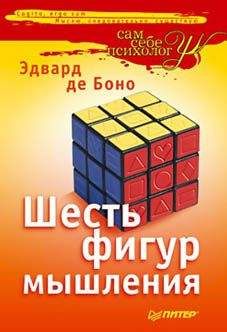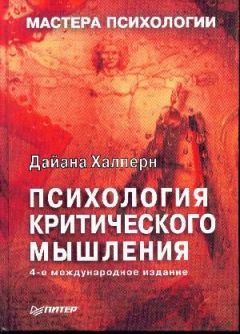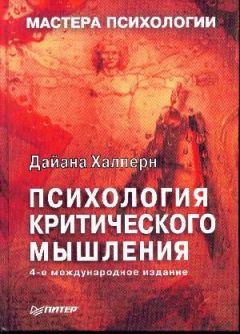Дайана Халперн - Психология критического мышления

Помощь проекту
Психология критического мышления читать книгу онлайн
LangerE. J. (1989). Mindfulness. Reading, MA: Addison-Wesley
Langer E. (1994, July). Improving the quality of thinking in a changing world. Paper presented at the Sixth International Conference on Thinking, Cambridge, MA.
LangerE. J., Blank A., Chanowitz B. (1978). The mind-lessness of ostensibly thoughtful action: The role of «placebic» information in interpersonal interaction. Journal of Personality and Social Psychology, 36, 635–642.
Langley P., Simon H. A., Bradshaw G. L., Zytkow J. M. (1987). Scientific discovery: Computational explorations of the creative process. Cambridge. MA: "MIT Press.
LangrehrS. (1990) Sharing thinking strategies. Bloom-ington, IN: National Educational Service.
Larrick R. P., Morgan J. N… Nisbett R. E. (1990). Teaching the use of cost-benefit reasoning in everyday life. Psychological Science, 1, 362–370.
Lee A.M. (1953). How to understand propaganda. New York: Holt, Rinehart Company.
Leedy P. D. (1981). How to read research and understand it. New York: Macmillan.
Lehman D. R., Lempert R. 0., Nisbett R. E. (1988). The effects of graduate training on reasoning: Formal discipline and thinking about everyday-life events. American Psychologist, pp. 431–442.
Lehman D. R., Nisbett R. E. (1990). A longitudinal study of the effects of undergraduate training on reasoning. Developmental Psychology, 26,431–442.
Leive C. (1994, April). Miss America. Glamour, pp. 234–237,275-281.
Levi D. S. (1991). Critical thinking and logic. Salem, WI: Sheffield.
Levine M. (1994). Effective problem solving (2nd ed.) Englewood Cliffs, NJ: Prentice-Hall.
Lewis А. В., Mayer R. E. (1987). Students' miscomprehension of relational statements in arithmetic word problems. Journal of Educational Psychology, 79, 363–371.
Lichtenstein S., Slovic P., Fischoff В., Layman M., Combs B. (1978). Judged frequency of lethal events. Journal of Experimental Psychology. Human Learning and Memory, 4, 551–578.
Lister P. (1992, July). A skeptics guide to psychics. Redbook, pp. 103–105, 112–113.
Little L. W., Greenberg I. (1991) Problem solving, critical thinking, and communication skills New York: Longman.
Lochhead J. Clement J. (Eds.). (1979). Cognitive process instruction: Research on teaching thinking skills. Philadelphia: Franklin Institute Press.
Lockhart R. S., Lamon M., Gick M. L. (1988). Conceptual transfer in simple insight problems. Memory and Cognition, 16, 36–44.
Loftus E. F. (1979). Eyewitness testimony. Cambridge, MA; Harvard University Press.
Loftus E. F. (1980). Memory: Surprising new insights into how we remember and why we forget. Reading, MA: Addison-Wesley.
Loftus E. F. (1993). The reality of repressed memories. American Psychologist, 44,518–537.
Loftus E. R, Ketchum K. (1994). The myth of repressed memory: False memories and the accusations of sexual abuse. New York: St. Martin's Press.
Loftus G.R., Loftus E. F. (1982). Essence of statistics. Monterey, CA: Brooks/Cole.
The Long Term View. (1994. Summer). Has American education forsaken critical thinking? [Special issue]. (Vol. 2, No. 3). Andover: Massachusetts School of Law.
Lopes L. L. (1982). Doing the impossible: A note on induction and the experience of randomness. Journal of Experimental Psychology: Learning. Memory Cognition, 8, 626–636.
Lorayne H. (1975). Remembering people. New York: Stein Day.
Lorayne H., Lucas J. (1974). The memory book. New York: Stein Day. (Also published in paperback by Ballantine Books, 1975)
Lord C, Ross L., Leppet M. (1979). Biased assimilation and attitude polarization: The effects of prior theories on subsequently considered evidence. Journal of Personality and Social Psychology, 37, 2098–2109.
Lowenfeld V. (1962). Creativity: Education's stepchild. In S., J. Parnes H. F. Harding (Eds.), A source book for creative thinking. New York: Scribner's.
Luchins A. S. (1942). Mechanization in problem solving: The effect of Einstellung. Psychological Monographs, 54(6, Whole No. 248).
Macmillan Publishers (1989). Macmillan dictionary of quotations. New York: Author.
Maier N. R. F. (1931). Reasoning in humans II: The solution of a problem and its appearance in consciousness. Journal of Comparative Psychology, 12,181–194.
Mann L. (1972). Use of a «balance sheet» procedure to improve the quality of personal decision making: A field experiment with college applicants. Journal of Vocational Behavior, 2, 291–300.
Marsh J. G., Shapira Z. (1982). Behavioral decision theory and organizational decision theory. In G. R.Ungson, D. N. Braunstein (Eds.), Decision making: An interdisciplinary inquiry. Boston, MA: Kent.
Matlin M. (1994). Cognition (3rd. ed.). Orlando, FL: Harcourt Brace.
Mayer R. E. (1987). Educational psychology A cognitive approach. Boston: Little, Brown.
Mayer R. E. (1992). Teaching of thinking skills in the sciences and mathematics. In D. F. Halpern (Ed.), Enhancing thinking skills in Ihe sciences and mathematics (pp. 95-116). Hillsdale, NJ: Lawrence Er-lbaum Associates.
McCormick С. В., Levin I. R. (1987). Mnemonic prose-learning strategics. In M. A. McDaniel M. Press-ley (Eds.), Imagery and related mnemonic processes (pp. 392–406). New York: Springer-Verlag.
McGuire W. /. (1981). The probabilogical model of cognitive structure and attitude change. In R. E. Petty, Т. М. Ostrom, Т. С Brock (Eds.), Cognitive responses in persuasion. Hillsdale, NJ: Lawrence Erlbaum Associates.
McKeachie W. J. (1992). Update: Teaching thinking. In D. J. Stroup and R. Allen (Eds.), Critical thinking: A collection of readings (p. 3). Dubuque, IA: Brown.
McKim R. H. (1980). Thinking visually: A strategy manual for problem solving. Belmont, CA: Wad-sworth.
McKinnon J. W., Renner J. W. (1971). Are colleges concerned with intellectual development? American Journal of Psychology. 39, 1047-1052
McTighe J. (1986). Thinking about adolescent thinking. The early adolescence magazine, 1,7-13.
Mednick S. A., Mednick M. T. (1967). Remote associates test: Examiners manual. Boston: Houghton Mifflin.
Meirovitz M. (1985). ThinkAbility. Hillsdale, NJ: Lawrence Erlbaum Associates.
Merron K., Fisher D., Torbert W. R. (1987). Meaning making and management action. Croup Organization Studies, 12, 274–286.
Messer W. S., Griggs R. A. (1989). Student belief and involvement in the paranormal and performance in
introductory psychology. Teaching of Psychology, 16(4), 187–191.
Miller J. ?., Jr. (1972). Words, self, reality: The rhetoric of imagination. New York: Dodd, Mead.
Milne A. A. (1926). Winnie the Pooh. New York: Dutton.
Moore B. N., Parker R. (1994). Critical thinking (4th ed.). Mountain View, CA: Mayfield.
Morgan J. J. В., Morton J. T. (1944). The distortion of syllogistic: reasoning produced by personal convictions. Journal of Social Psychology, 20, 39–59.
Moss J. (1950). How to win at poker. Garden City, NY: Garden City Books.
Mumford M. D., Gustafson S. B. (1988). Creativity syndrome: Integration, application, and innovation. Psychological Bulletin, 103, 27–43.
Munby И. (1982). Science in the schools. Toronto: University of Toronto.
Munson R. (1976). The way of words. Boston: Hough-ton Mifflin.
Myers D. G. (1995). Psychology. New York: Worth.
Mynatt C. R., DohertyM. ?., Twewy R. D. (1978). Consequences of confirmation and disconfirmation in a simulated research environment Quarterly Journal of Experimental Psychology, 30, 395–406.
Narode R., Heiman M., Lochhead J., Slomianko J. (1987). Teachingthinkingskills; Science. Washington, DC: National Education Association.
National Commission on Excellence in Education. (1983). A nation at risk: The imperative for educational reform. Washington, DC: Author.
National Education Goals Panel. (1991). The national education goals report: Building a nation of learners. Washington, DC: U.S. Government Printing Office.
National Research Council. (1994). Learning, remembering, believing: Enhancing human performance. Washington, DC: National Academy Press.
NeisserU. (1982). Memory observed: Remembering in natural contexts. San Francisco; Freeman.
Nelson Т. О. (Ed.). (1992). Metacognition: Core readings. Boston: Allyn Bacon.
Nelson T. O., Narens L. (1990). Metamemory: A theoretical framework and new findings. The psychology of learning and motivation, 26, 125–141.
Neubert G. A., Binko, J. B. (1992). Inductive reasoning in the secondary classroom. Washington, DC: National Education Association.
Neustadt R. ?., May E. R. (1986). Thinking in time: The uses of history for decision makers. New York: The Free Press.
Newell A. (1983). The heuristic of George Polya and its relation to artificial intelligence. In R. Groner, M. Groner W. F. Bischof (Eds.), Methods of heuristics (pp. 195–243). Hillsdale, N1: Lawrence Er-Ibaum Associates.
Newell A., Simon H. A. (1972). Human problem solving. Englewood Cliffs, NJ: Prentice-Hall.
Nickerson R. S. (1986). Reflections on reasoning. Hills-dale, NJ: Lawrence Erlbaum Associates.
Nickerson R. S. (1987). Why teach thinking? In J. B. Baron. R. J. Sternberg (Eds.), Teaching thinkingskills: Theory and practice (pp. 27–37). New York: Freeman.
Nlckerson R. S., Adams M. J. (1979). Long-term memory for a common object. Cognitive Psychology, 11,287–307.
The nightly crime news. (1994, March 21). Newsweek, p. 71.
Nisbett R. E. (Ed.). (1993). Rules for reasoning. Hills-dale, NJ: Lawrence Erlbaum Associates.
Nisbett R. E., Ross L. (1980). Human inference: Strategies and shortcomings of social judgment. Engle-wood Cliffs, NJ: Prentice-Hall.
Nisbett R. E., Wilson T. D. (1977). Telling more than we can know: Verbal reports on mental processes. Psychological Review, 7, 231–259.
Nixon R M. (1962). Six crises, Garden City, NY: Dou-bleday.
Norman D. A. (1976). Memory and attention: An introduction to human information processing. New York: Wiley.
Norman D. A. (1988). The psychology of everyday things. New York: Basic Books.
Norris S. P. (1992). Introduction: The generalizability question. In S. P. Norris (Ed.), The generalizability of critical thinking (pp. 1-15). New York: Teachers College Press.
Norris S. P., Ennis R. H. (1989). Evaluating critical thinking. Pacific Grove, CA: Critical Thinking Press Software.
Nutrition Action Health Letter. (1991, July/Aug) Eater's Digest, p. 13.
Oppenheimer J. R. (1956). Analogy in science. American Psychologist, 11,127–135.
Ortho Pharmaceutical Corp. (1979). The pill-After your doctor prescribes… Raritan, NJ: Author.
Orwell G. (1949). 1984. New York: Harcourt, Brace.
Osborn A. F. (1963). Applied imagination: Principles and procedures of creative problem solving (3rd rev. ed.). New York: Scribner's.
Osgood С. Е. (1953). Method and theory in experimental psychology. New York: Oxford University Press.
Oskamp S. (1965). Overconfidence in case-study judgments. Journal of Consulting Psychology, 29, 261–265.
Palincsar A. S., Brown A. L. (1984). Reciprocal-teaching of comprehension-monitoring activities. Cognition and Instruction, 1, 117–175.
Papanek V. J. (1977). Tree of life: Bionics. In S. J. Par-nes, R. B. Noller, A. M. Biondi (Eds.), Guide to creative action: Revised edition of creative behavior guidebook. New York: Scribner's.
Parducci A. (1968). The relativism of absolute judgments. Scientific American, 219, 84–90.
Park D. С (1992). Applied cognitive aging research. In F. I. M, Craik, T. A. Salthouse (Eds.), The handbook of aging and cognition (pp. 449–494). Hills-dale, NJ: Lawrence Erlbaum Associates.
Parnes S. J. (1967). Creative behavior workbook. New York: Scribner's.
Parnes S. J., Noller R. В., Biondi A. M. (1977). Guide to creative action: Revised edition of creative behavior guidebook. New York: Scribner's.
Patterson M. E., Dansereau D. F., Wiegmann D. A. (1993). Receiving information during a cooperative episode: Effects of communication aids and verbal ability, Learning and Individual differences, 5, 1-11.
Paulos J. A. (1994, March). Commentary: Countingon dyscalculia. Discover, p. 30–36.
Payne I. W, Bettman J. R., Johnson E. J. (1993). The adaptive decision maker, Cambridge, England: Cambridge University Press.
Pea R. D., Hawkins J. (1987). Planning in a chore-scheduling task. In S. L. Friedman, E. K. Scholnick, R. R. Cocking (Eds.), Blueprints for thinking: The role of planning in cognitive development (pp. 273–302). Cambridge, MA: Cambridge University Press.
Peck J. (1986). Not killing is a crime? In B. Lown E. Chazov (Eds.), Peace: A dream unfolding (p. 146). Ontario, Canada: Somerville House Books Ltd.

























